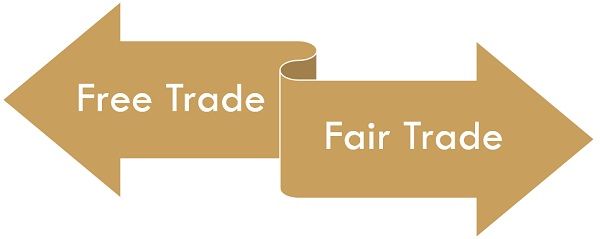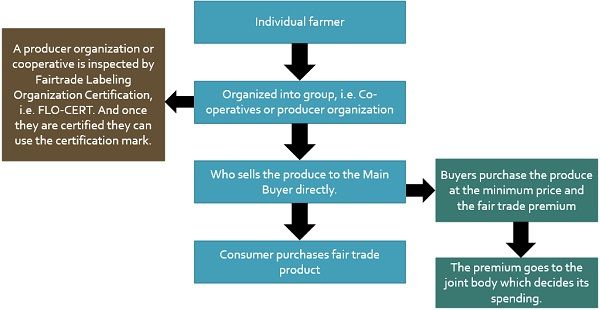 Free Trade, as the name describes, is the unrestrained flow of products, services, labour and capital, across the country’s geographical boundaries, without any government intervention in the name of economic or regulatory barriers. The term ‘free trade’ is often contrasted with ‘fair trade’.
Free Trade, as the name describes, is the unrestrained flow of products, services, labour and capital, across the country’s geographical boundaries, without any government intervention in the name of economic or regulatory barriers. The term ‘free trade’ is often contrasted with ‘fair trade’.
In the simplest sense, the word ‘fair trade‘ means the kind of buying and selling of goods and services in which fair, i.e. just and equitable, payment is made to the producers. It is an international-level social movement which composed of a myriad network of producers, companies, consumers, and organizations, whose purpose is to ameliorate the environmental and labour standards.
In this session, we will talk about the differences between free trade and fair trade.
Content: Free Trade Vs Fair Trade
Comparison Chart
| Basis for Comparison | Free Trade | Fair Trade |
|---|---|---|
| Meaning | Free Trade implies the bilateral trade agreements which liberalize the exchange of goods and services between trading partners. | Fair Trade is a trade amidst companies (developed country) and working community (developing country), wherein equitable prices are paid to the latter. |
| Trade | Trade among countries | Trade amidst individuals and businesses |
| Focuses on | Minimizing the barriers and policies which backs certain countries or industries. | Promoting the rights of workers, good working conditions and aspire to remove pay discrepancies between countries. |
| Objective | To boost the economic growth of the country. | To develop more equitable trade relationships. |
| Steps | Lowering tariffs, quotas, embargoes and regulatory trade barriers. | Firms work with peasants and artisans, which ensures suitable financing and wage. |
| Benefits | Companies who import and export their goods in the participating nations. | Peasants and craftsmen to whom economic and social opportunities are unavailable. |
| Supply chain | Complex | Simple |
| Regulations | Fewer regulations on the exchange of goods and services, abroad. | Certain regulations to ensure that corporations do not take advantage of farmers. |
Definition of Free Trade
Free Trade as the name suggests demands liberalization from the trade barriers in the international market. It is a policy, which states that the government does not differentiate against the imports or restrict export by levying taxes.
It lays emphasis on lifting restrictions, import taxes, i.e. tariffs, subsidies on exports, trade regulations, embargoes, and other non-tariff barriers which are imposed on the exchange of goods and services to/from foreign countries.
In other words, free trade refers to the full-fledged elimination of the trade barriers, to promote free movement of goods, services, labour and capital, globally. However, complete removal of barriers is theoretical, as practically government imposes certain measures to keep a check on imports and exports.
Free Trade not just boost the efficiency of the international market but also helps in the economic growth of the participating countries. Typically, the participating countries enter into a bilateral agreement, which permits import and export of goods and services, without any restrictions.
Benefits of Free Trade
- Drives competitiveness
- Increases access to high-quality goods at reasonable prices
- Improves efficiency
- Supports innovation
- Promotes transparency and fairness
Definition of Fair Trade
Fair Trade is mainly concerned with the impact of the trade on environment, labour standards and human rights overseas, so as to take steps to improve those effects.
Fair Trade refers to a trading arrangement formed on the basis of dialogue, openness and respect, which strives for higher fairness in the trade across the border.
Fair Trade aims at minimizing exploitation in the trade market, as well as reducing human rights violations and violations to environmental rules. It also empowers the farmers, artisans and small producers to support themselves. And to do so, the rights of people belonging to marginalized groups are protected by way of fair wages and better working conditions, which contributes to sustainable development.
Fair Trade helps the poor farmers, artisans and producers by providing fair and suitable price for their produce which covers the cost of production. It also allows them to get access to interest-free loans, or loans at the nominal interest rate. It ensures – fair prices, safe working conditions, conservation of natural resources and no enforced child labour.
Fair Trade Model
 Many organizations across the world are associated with fair trade who actively stand up for the producers, raise awareness and carry out campaigns for implementing change in the existing trade rules and practices.
Many organizations across the world are associated with fair trade who actively stand up for the producers, raise awareness and carry out campaigns for implementing change in the existing trade rules and practices.
Key Differences Between Free Trade and Fair Trade
The points given below are substantial so far as the difference between free trade and fair trade is concerned:
- Free Trade refers to trade policy to loosen or remove trade restrictions globally to ensure unrestricted movement of goods and services across nations. On the other hand, Fair trade is a partnership arrangement in which the producers in developing countries are given just and equitable return for their work, by the companies based in developed countries.
- Free Trade involves trade amongst countries, whereas fair trade entails trading partnership amidst firms and working communities.
- Free Trade focuses on lessening the barriers and policies which supports certain countries or industries. On the other hand, fair trade tends to promote the rights of workers, good working conditions and works for removing the differences in wages from one country to another.
- Free Trade aims at boosting the economic growth of the country. As against, the objective of fair trade is to develop more equitable trade relationships, by empowering those who are marginalized and improving their living standards.
- To implement free trade, countries lower down tariffs, quotas and regulatory trade barriers. Conversely, to implement fair trade, firms shook hands with peasants and artisans, which ensures suitable financing and wage.
- Free trade benefits the firms which are involved in the import and export of goods in the participating countries. Conversely, fair trade benefits working communities, i.e. peasants and craftsmen to whom economic and social opportunities are unavailable.
- In free trade, the supply chain is complex due to multiple levels amidst the producers and consumers. As against, in fair trade, the supply chain is clear and simple as well, because of direct partnership which accounts for the requirement of specific communities.
- In a free trade, there are only a few regulations on the exchange of goods and services, in other countries. In contrast, in the case of fair trade, there are certain regulations to ensure that corporations do not take advantage of farmers.
Conclusion
By and large, free trade is a pact which says that the participating nations can import and export goods without any tariff barriers or other non-tariff barriers to trade. On the other hand, fair trade is all about fairness in price, working conditions, sustainability and terms of trade, with the working community.






Leave a Reply